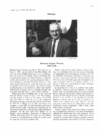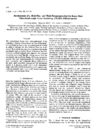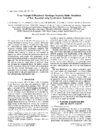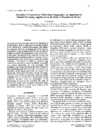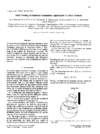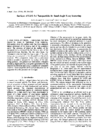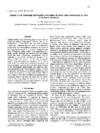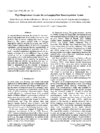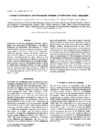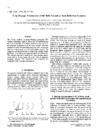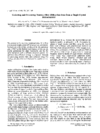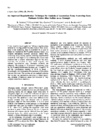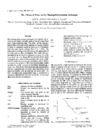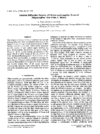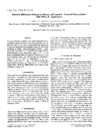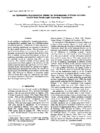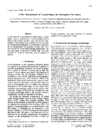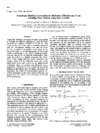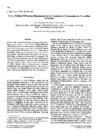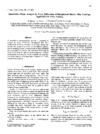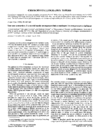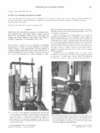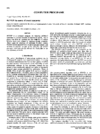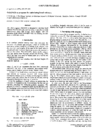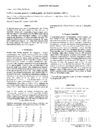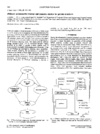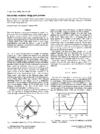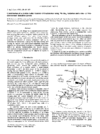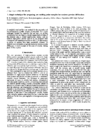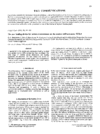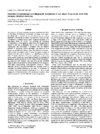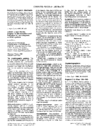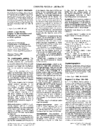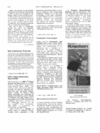issue contents
August 1996 issue

Cover illustration: Neutron scattering pattern in the (hk0) reciprocal-lattice plane from alpha-AgI at 520 K. The portion shown extends from 0 to 5.4 reciprocal-lattice units in both h and k. Courtesy of D. A. Keen, V. M. Nield and R. L. McGreevy.
obituaries
Free 

research papers
The densities of protein crystals have been determined by crys- tal-volume measurement and amino-acid analysis. The method includes free mounting of protein crystals, humidity control and crystal-shape measurements.
A high-flux and high-temperature-set-up Bonse–Hart ultra- small-angle X-ray scattering (USAXS) diffractometer useful for the study of phase transitions has been constructed.
The application of the MULTX program for predicting Renninger scanning multiple diffraction data is extended to allow for the simulation of synchrotron-radiation data.
An algorithm for the simulation of synchrotron white-beam topographs on massively parallel machines is presented.
A statistical method for defining the preferred-orientation plane is discussed and applied.
Information about particle surface in a dilute system of nearly isotropic particles is obtained from the zero limit of the chord distribution and the Porod asymptote.
Detailed diffuse X-ray scattering patterns have been recorded at both ambient (295 K) and low (130–150 K) temperatures for two urea inclusion compounds. The work convincingly demonstrates that the scattering is due to the orientational disorder of the alkanes within the channels of the urea framework, together with accompanying relaxations of the framework itself.
A furnace, operating between ambient temperature and 1500 K, is described for the automatic collection of X-ray diffraction data on an on-line imaging-plate scanner system (MAR Research). The furnace was used to study the temperature dependence of the complex diffraction phenomena occurring in the decagonal quasicrystal Al72.7Co11.6Ni15.7.
White-beam synchrotron topography has been used to study domain structures in several typical ferroelastic and ferroelectric crystals, from which the general mechanisms underlying the domain diffraction by continuous X-ray topography are presented and discussed.
Two X-ray methods in back-reflection geometry (diffraction techniques with Ni Kα or Cu Kα radiation, Laue technique with `white' radiation) used for the polytype examination of SiC bulk crystals are described.
An optimum strategy for collecting fibre diffraction data from a neutron single-crystal diffractometer is proposed. Methods for processing data collected using this strategy are described and illustrated by studies on cellulose.
A new iterative way to apply the Tikhonov regularization method for solving partial structure factors from anomalous wide-angle X-ray scattering data is presented.
The effects of noise on the missing-data-residue technique are investigated and it is shown that improved results can be obtained by smoothing of the data.
Electron Diffraction Patterns of Fibrous and Lamellar Textured Polycrystalline Thin Films. I. Theory
A unified geometric theory of electron diffraction patterns of fibrous and lamellar textured polycrystalline thin films has been developed. Expressions that relate the angles subtended by diffraction arcs to the distribution angle of the texture are derived.
Electron diffraction patterns of a sputter-deposited polycrystal- line MgO thin film on an SiO2 substrate, of a Ta thin film and of CoCrTa/Cr bilayer films on glass substrates are presented and analyzed based on the theory developed in Paper I by Tang & Laughlin [J. Appl. Cryst. (1996). 29, 411–418].
All three partial structure factors in a bimodal colloidal mixture can be determined using a solvent contrast-variation technique. A new optimization regularization method is developed and applied to a model set of small-angle scattering data, providing stable solutions.
Measurements of crystal shapes made using a charge-coupled-device camera and computer graphics are described.
The anisotropic elasticity corrections are obtained to evaluate the reflection efficiency and the X-ray standing-wave patterns for bent silicon [orientation (111)] and quartz [orientations (11.0) and (10.1)].
This paper describes X-ray multiple diffraction applied to the characterization of crystalline perfection. The effects of primary and secondary extinction on three-beam diffraction cases are described.
The application of a multilayered thin-film phase analysis to α/β brass layers is described.
cryocrystallography papers
An easily assembled stationary nozzle accessory designed for the Siemens/Nicolet LTII low-temperature device with standard coaxial nozzle arrangement is described. The attachment significantly improves the efficiency of the cooling device as well as the versatility of the diffractometer.
Modifications are described that eliminate ice build-up during data collection from cryo-cooled protein crystals using an RAXIS IIC imaging-plate system and its associated cool nitrogen stream apparatus.
short communications
High-resolution neutron powder diffraction has been used to positively establish the difference between the thermal parameters of metal and nonmetal ions in TiN.
computer programs
A new program for detecting missing symmetry elements in crystal structures is described.
The DOS program VALENCE is designed to calculate bond valences from bond lengths and vice versa. It can also calculate bond-valence sums and average bond lengths, and can determine bond-valence parameters from the bonding environments of various cations.
A space-group-general radix-2 crystallographic fast Fourier transform has been written in only 130 lines of executable Fortran code.
PDBtool is an X/Motif-based tool for studying the features, notably geometry, of macromolecules in Protein Data Bank format.
laboratory notes
A Hewlett-Packard ScanJet scanner, equipped with a transparencies adaptor, has been used as an X-ray photograph densitometer. After calibration with a Kodak step tablet, this system allows the quantitative acquisition of two-dimensional X-ray diffraction patterns from oriented material.
Oscillatory Bragg peak positions are explained using a decoupled system of equations for X-ray diffraction. The refinable parameters, Bragg angle, misorientation and phase shift can be determined with high accuracy.
A double-radius Guinier diffractometer that uses Mo Kα 1 radiation and a curved imaging-plate detector is recommended as a competitive in-house apparatus for powder measurements of high resolution and accuracy.
A straightforward and low-cost method using a chilled stainless-steel mortar is presented to enable highly crystalline powder samples of low-melting-point organic materials to be prepared.
fast communications
Texture measurement with applied uniaxial tension has been performed. The influence of tensile loading during neutron texture measurement is shown.
In difficult inorganic systems where experimental diffraction data are too scant for crystal structure analysis, ab initio molecular dynamics simulations can suggest structure solutions in the form of atomic coordinates in huge simulation boxes. The deductive algorithm developed here transforms these coordinates into conventional crystallographic descriptions, allowing comparision with available experimental data: difraction, spectroscopic or other.
computer program abstracts
LAUEX is a user-friendly program running on UNIX systems. It enables the simulation of Laue diagrams from the knowledge of the crystal parameters and orientation, and the indexation of experimental diagrams.
crystallographers
Free 

new commercial products
Free 



 journal menu
journal menu









